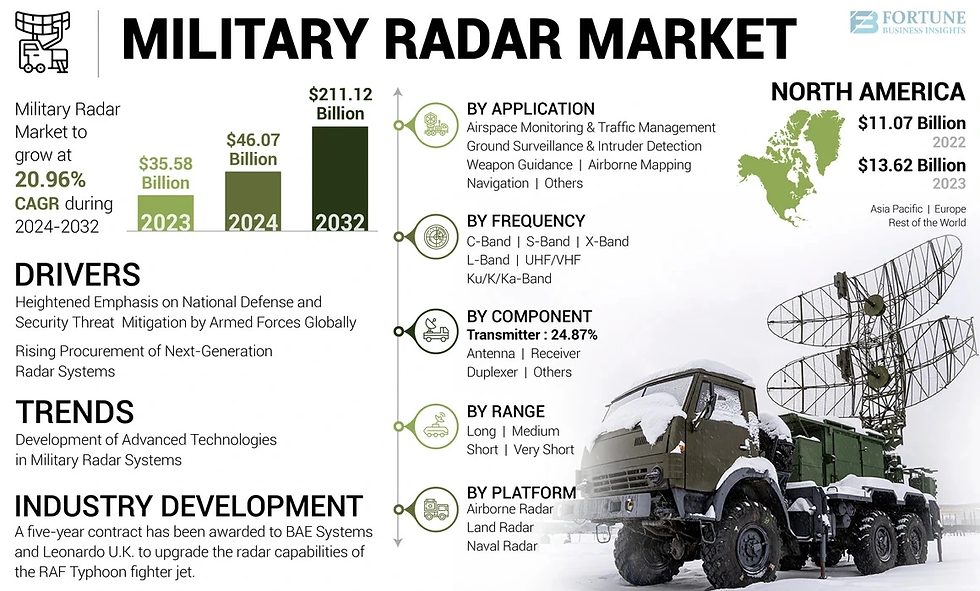Military Radar Market Size, Share, Forecast and Opportunities, 2032
- Rishika Chavan
- Sep 23
- 3 min read
According to Fortune Business Insights™, the global military radar market was valued at USD 35.58 billion in 2023 and is projected to rise from USD 46.07 billion in 2024 to USD 211.12 billion by 2032, exhibiting a CAGR of 20.96% during the forecast period. North America led the market with a 38.28% share in 2023, with the U.S. emerging as the largest contributor, expected to reach USD 63.69 billion by 2032.
Radar systems remain a cornerstone of modern defense platforms, supporting applications such as surveillance, target tracking, air traffic monitoring, weapon guidance, and border protection. Technological advancements including AESA (Active Electronically Scanned Array), over-the-horizon radars, and AI-enabled threat detection are driving market growth.
Russia-Ukraine War Impact
The Russia-Ukraine conflict has significantly accelerated global demand for advanced radar systems. Both nations, along with regional allies, have increased defense spending to enhance situational awareness and air defense capabilities. For example, in 2023, Thales and the French Ministry of Defense delivered a Ground Master 200 radar to Ukraine, strengthening short-range air defense.
This geopolitical crisis has pushed NATO and European states to fast-track procurement of 3D radars, integrated air defense solutions, and joint radar modernization programs.

Key Market Insights
2023 Market Size: USD 35.58 billion
2024 Market Size: USD 46.07 billion
2032 Forecast: USD 211.12 billion
CAGR (2024–2032): 20.96%
Regional Leader: North America with 38.28% market share in 2023
Market Dynamics
Growth Drivers
Rising Defense Expenditure Globally – Nations such as the U.S., China, and India are prioritizing radar system procurement to strengthen national security.
Next-Generation Radar Technologies – Development of over-the-horizon radars, phased array radars, and long-range detection systems is boosting adoption.
Modernization of Existing Platforms – Military programs worldwide are upgrading naval, airborne, and land-based radar capabilities to counter evolving threats.
Restraining Factors
Stealth Technology Advancements: Aircraft like the U.S. B-21 Raider and radar-absorbing materials reduce detection capability.
Radar Jamming and Electronic Warfare: Systems like Hensoldt’s Kalaetron Attack disrupt enemy radar efficiency, posing challenges to radar operators.
Information Source:
Segmentation Analysis
By Component
Antenna dominated in 2023 and is projected to be the fastest-growing segment, driven by demand for accurate detection.
Transmitter expected to expand steadily due to its role in extending radar lifespan and efficiency.
By Frequency
UHF/VHF segment to grow fastest owing to adoption in ground-based surveillance.
S-Band radars held the largest share in 2023 due to high accuracy in military applications.
By Range
Long-range radars projected to witness highest CAGR, supported by large-scale defense procurements (e.g., Indonesia’s 13 GM400 Alpha radars).
Short-range radars dominated in 2023 with widespread adoption in battlefield surveillance.
By Platform
Airborne radars forecasted to grow fastest due to rising demand for air defense and UAV detection.
Land radars held the largest share in 2023, with increasing adoption in territorial surveillance.
By Application
Airspace monitoring & traffic management to witness fastest growth with heavy investments in air defense networks.
Ground surveillance & intruder detection dominated in 2023 due to expanding border security operations.
Regional Insights
North America: Largest market at USD 13.62 billion in 2023, supported by U.S. defense budgets and procurement of advanced radars like AN/SPY-6.
Asia Pacific: Fastest-growing region with major investments from China, India, and South Korea in naval and airborne radar programs.
Europe: Rising demand driven by NATO-led radar modernization and the Russia-Ukraine war.
Rest of the World: Growth fueled by defense investments in Latin America and the Middle East for surveillance and missile defense.
Competitive Landscape
The market is moderately consolidated with global leaders investing in R&D, acquisitions, and collaborations. Players are expanding portfolios with next-generation radar technologies to enhance long-range detection, counter-UAS capabilities, and integrated defense solutions.
Key Companies:
Raytheon Technologies Corporation (U.S.)
Lockheed Martin Corporation (U.S.)
Northrop Grumman Corporation (U.S.)
BAE Systems plc (U.K.)
Thales Group (France)
Saab AB (Sweden)
Israel Aerospace Industries Ltd. (Israel)
Hensoldt AG (Germany)
Leonardo S.p.A (Italy)
Hanwha Systems Co. Ltd. (South Korea)
L3Harris Technologies, Inc. (U.S.)
Honeywell International Inc. (U.S.)
Recent Industry Developments
July 2023 – BAE Systems & Leonardo awarded a USD 958.9 million contract to upgrade RAF Typhoon fighter jet radars with ECRS Mk2.
May 2023 – Lockheed Martin received a USD 2.3 billion contract to enhance PATRIOT radar systems.



Comments